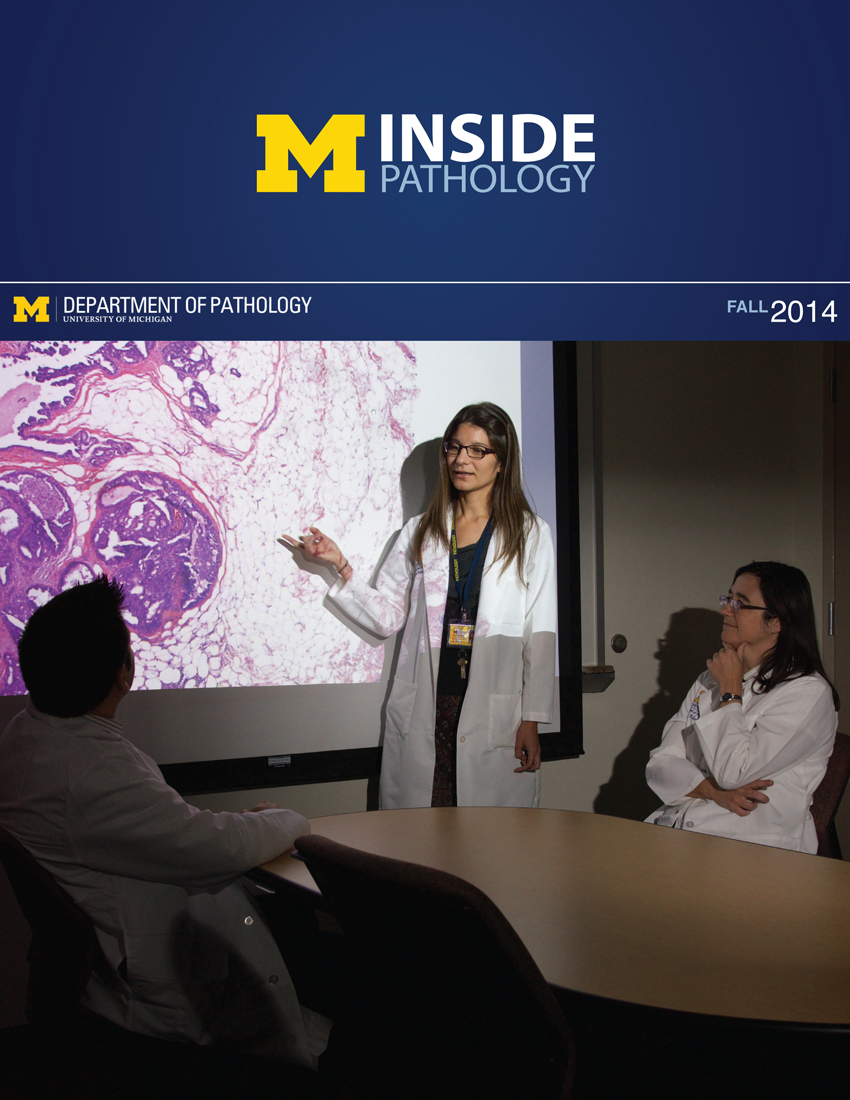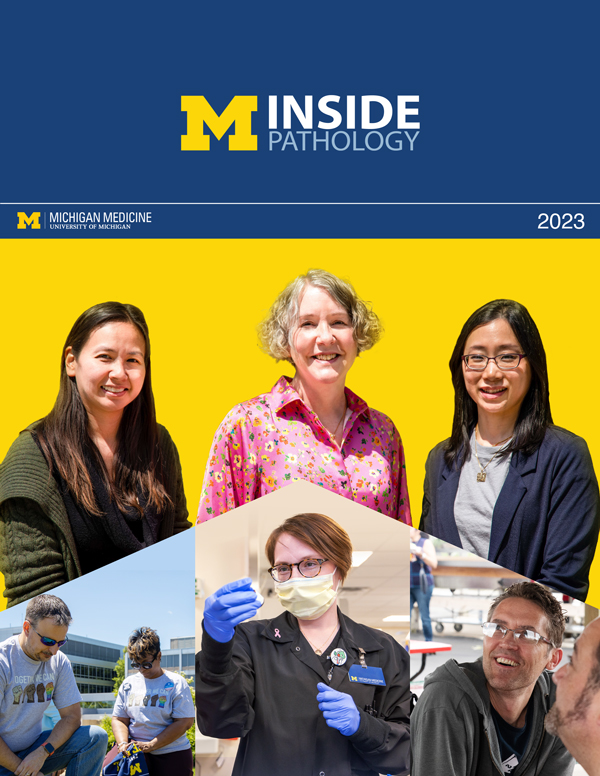


Dr. Peter Ward posing for his Endowed Professorship portrait.
Photo by Elizabeth Walker
In the summer of 1980, I returned to the University of Michigan as chair of the Department of Pathology, where I had trained as a resident. At that time, the Department had over 50 full-time faculty members, with strong clinical programs representing all the subspecialties. The Department was also known for its excellent teaching programs. As chair, I wanted to build our research capabilities. As a first step, several teaching laboratories were relocated to the adjacent School of Nursing in order to free up departmental space for 5 modern research laboratories.
The 1980s were an exciting time for pathology research. My own work was in the field of complement and immunopathology with an emphasis on inflammation: Why and under what conditions was it involved in lung disease? Complement is a series of plasma proteins that are involved in immune defenses against infectious agents. Several of my younger colleagues moved with me from the University of Connecticut Health Center, where I had previously served as department chair, to research these questions at UMHS. As immunology became more sophisticated, it became clear that many diseases were triggered by an immune response. The development of tools such as ELISA assays provided fast, larger-scale methods for measuring immune responses in individual patients. Suddenly, my U-M colleagues and I had access to a wealth of new detection systems.
Two years into my tenure as chair, I assumed duties as interim dean of the Medical School (1982-1985). One of my roles was to help the basic science departments increase their research funding through R01 grants. I supported enhancing collaborations between the basic sciences and the various clinical departments. The National Institutes of Health (NIH) encouraged clinically-related research because the results helped justify congressional funding of the NIH. In fact, between the end of World War II and up until just ten years ago, Congress expanded the NIH budget from 7-12% per year. This was possible because legislators appreciated how NIH-supported research allowed clinicians to provide better treatments. For example, between the mid-1950s and the 1980s, the incidence of cardiac deaths from heart attacks plummeted and lifespans increased because of better treatment of cardiovascular diseases.
Here in the Department of Pathology we collaborate with a number of clinical programs. For example, for the past 15 years, Pathology has partnered with the Department of Urology using genomic sequencing to identify specific types of prostate tumors and predict how they will respond to various therapies. As a result of this kind of cancer research, there has been a tremendous evolution in the specialty areas of pathology. Surgical pathologists can now relay much more information about a particular tumor. The patient’s physician can then use this information to determine whether and how to treat it. We’re seeing things we never dreamed of even ten years ago. It’s a fascinating time.
In 2005, then-Dean of the Medical School Allen Lichter and I agreed that after 25 years of my being chair of the Department of Pathology, it was a time for change. Jay Hess, M.D., Ph.D., M.H.S.A., was recruited as my replacement. Hess had trained as a diagnostic surgical pathologist and was working as a hematopathologist at the University of Pennsylvania. He had expertise in defining molecular mechanisms in cancer, especially in hematologic cancers. With his arrival at UMHS, Dr. Hess played a key role in expanding an epigenetics research program in Pathology, recruiting new faculty with expertise in leukemia, transcriptional activation, histone modifications, genome deep sequencing, and use of mouse leukemia models. The epigenetics and leukemia group has published several important papers, which have made meaningful contributions to the translation of basic science research into clinical practice. Dr. Hess also recruited Jeff Myers, M.D., A. James French Professor of Diagnostic Pathology, to lead the Division of Surgical Pathology. Kojo Elenitoba-Johnson, M.D., was also recruited and helped develop the new Molecular Diagnostics Laboratory.
Soon thereafter, the Medical School created the Strategic Research Initiative, which aligns the Medical School and UMHS around a common research vision. Among other projects, the program supports the Protein Folding Diseases Initiative, which provides funding for the study of protein folding diseases. This research is currently led by Pathology researchers, working in collaboration with other U-M scientists. By the time Hess left UMHS in 2014, he and his colleagues had developed a state-of-the-art, sophisticated proteomics core laboratory that would have very positive impacts on research programs in Pathology and beyond.
In the fall of 2015, Charles Parkos, M.D., Ph.D., from Emory University, became chair of Pathology and the Carl Vernon Weller Professor Pathology. Parkos is well-known for his research into the role of junctional proteins that regulate the epithelial barrier in the small bowel. The Department of Pathology appears to be in excellent hands for the coming years.
Portrait of a young Dr. Ward.
Pathology Faculty, circa 1993.
Dr. Ward working in his office.
At a holiday party in the Towsley lobby.
With regent Sarah Power at the groundbreaking for the current U-M Hospital which opened in 1986.
Dr. Ward (far right) on a Medical Committee.
Dr. Ward overseeing the work with staff on the current U-M Hospital.
Dr. Ward (Far Left) and Dr. Naylor (Far Right).
Presentation of oil painting of Dr. Ward.
Dr. Ward with Janani Krishnaswami, recipient of the Ward Pathology Medical Education Scholarship, and Dean Lichter.
 ON THE COVER
ON THE COVER
Breast team reviewing a patient's slide. (From left to right) Ghassan Allo, Fellow; Laura Walters, Clinical Lecturer; Celina Kleer, Professor. See Article 2014Department Chair |

newsletter
INSIDE PATHOLOGYAbout Our NewsletterInside Pathology is an newsletter published by the Chairman's Office to bring news and updates from inside the department's research and to become familiar with those leading it. It is our hope that those who read it will enjoy hearing about those new and familiar, and perhaps help in furthering our research. CONTENTS
|
 ON THE COVER
ON THE COVER
Autopsy Technician draws blood while working in the Wayne County morgue. See Article 2016Department Chair |

newsletter
INSIDE PATHOLOGYAbout Our NewsletterInside Pathology is an newsletter published by the Chairman's Office to bring news and updates from inside the department's research and to become familiar with those leading it. It is our hope that those who read it will enjoy hearing about those new and familiar, and perhaps help in furthering our research. CONTENTS
|
 ON THE COVER
ON THE COVER
Dr. Sriram Venneti, MD, PhD and Postdoctoral Fellow, Chan Chung, PhD investigate pediatric brain cancer. See Article 2017Department Chair |

newsletter
INSIDE PATHOLOGYAbout Our NewsletterInside Pathology is an newsletter published by the Chairman's Office to bring news and updates from inside the department's research and to become familiar with those leading it. It is our hope that those who read it will enjoy hearing about those new and familiar, and perhaps help in furthering our research. CONTENTS
|
 ON THE COVER
ON THE COVER
Director of the Neuropathology Fellowship, Dr. Sandra Camelo-Piragua serves on the Patient and Family Advisory Council. 2018Department Chair |

newsletter
INSIDE PATHOLOGYAbout Our NewsletterInside Pathology is an newsletter published by the Chairman's Office to bring news and updates from inside the department's research and to become familiar with those leading it. It is our hope that those who read it will enjoy hearing about those new and familiar, and perhaps help in furthering our research. CONTENTS
|
 ON THE COVER
ON THE COVER
Residents Ashley Bradt (left) and William Perry work at a multi-headed scope in our new facility. 2019Department Chair |

newsletter
INSIDE PATHOLOGYAbout Our NewsletterInside Pathology is an newsletter published by the Chairman's Office to bring news and updates from inside the department's research and to become familiar with those leading it. It is our hope that those who read it will enjoy hearing about those new and familiar, and perhaps help in furthering our research. CONTENTS
|
 ON THE COVER
ON THE COVER
Dr. Kristine Konopka (right) instructing residents while using a multi-headed microscope. 2020Department Chair |

newsletter
INSIDE PATHOLOGYAbout Our NewsletterInside Pathology is an newsletter published by the Chairman's Office to bring news and updates from inside the department's research and to become familiar with those leading it. It is our hope that those who read it will enjoy hearing about those new and familiar, and perhaps help in furthering our research. CONTENTS
|
 ON THE COVER
ON THE COVER
Patient specimens poised for COVID-19 PCR testing. 2021Department Chair |

newsletter
INSIDE PATHOLOGYAbout Our NewsletterInside Pathology is an newsletter published by the Chairman's Office to bring news and updates from inside the department's research and to become familiar with those leading it. It is our hope that those who read it will enjoy hearing about those new and familiar, and perhaps help in furthering our research. CONTENTS
|
 ON THE COVER
ON THE COVER
Dr. Pantanowitz demonstrates using machine learning in analyzing slides. 2022Department Chair |

newsletter
INSIDE PATHOLOGYAbout Our NewsletterInside Pathology is an newsletter published by the Chairman's Office to bring news and updates from inside the department's research and to become familiar with those leading it. It is our hope that those who read it will enjoy hearing about those new and familiar, and perhaps help in furthering our research. CONTENTS
|
 ON THE COVER
ON THE COVER
(Left to Right) Drs. Angela Wu, Laura Lamps, and Maria Westerhoff. 2023Department Chair |

newsletter
INSIDE PATHOLOGYAbout Our NewsletterInside Pathology is an newsletter published by the Chairman's Office to bring news and updates from inside the department's research and to become familiar with those leading it. It is our hope that those who read it will enjoy hearing about those new and familiar, and perhaps help in furthering our research. CONTENTS
|
 ON THE COVER
ON THE COVER
Illustration representing the various machines and processing used within our labs. 2024Department Chair |

newsletter
INSIDE PATHOLOGYAbout Our NewsletterInside Pathology is an newsletter published by the Chairman's Office to bring news and updates from inside the department's research and to become familiar with those leading it. It is our hope that those who read it will enjoy hearing about those new and familiar, and perhaps help in furthering our research. CONTENTS
|
 ON THE COVER
ON THE COVER
Rendering of the D. Dan and Betty Khn Health Care Pavilion. Credit: HOK 2025Department Chair |

newsletter
INSIDE PATHOLOGYAbout Our NewsletterInside Pathology is an newsletter published by the Chairman's Office to bring news and updates from inside the department's research and to become familiar with those leading it. It is our hope that those who read it will enjoy hearing about those new and familiar, and perhaps help in furthering our research. CONTENTS
|

MLabs, established in 1985, functions as a portal to provide pathologists, hospitals. and other reference laboratories access to the faculty, staff and laboratories of the University of Michigan Health System’s Department of Pathology. MLabs is a recognized leader for advanced molecular diagnostic testing, helpful consultants and exceptional customer service.